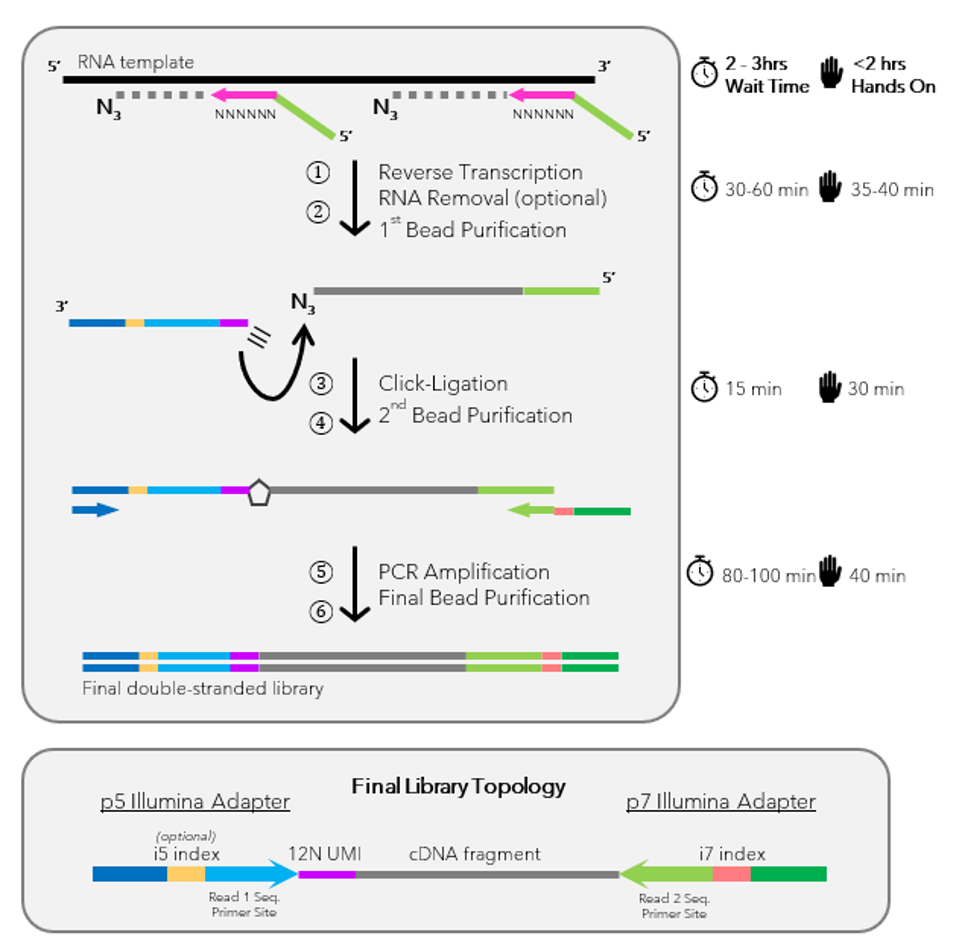X-ClickSeq Library Prep Kit 12 Reactions
ClickSeq kit compatible with user-provided primers in reverse-transcription reaction

-
ClickSeq is a simple method for the synthesis of Next-Generation Sequencing (NGS) libraries and offer a Next Generation Sequencing amplification kit. ClickSeq derives its names by using ‘Click-Chemistry‘ in the place of common ligation enzymes to ‘click-ligate’ nucleic acids to sequencing adaptors – an essential and often problematic step in the synthesis of Next-Generation Sequencing cDNA libraries. The process takes advantage of the chain-terminating properties of 3′-azido-nucleotides, which are included the initial in vitro reverse-transcription reactions uniformly required for RNAseq. The modified nucleotides are stochastically incorporated into the nascent cDNA, yielding cDNA fragments blocked at their 3′ ends with azido groups. The 3′-azido-blocked cDNA fragments are ‘click-ligated’ onto alkyne-functionalized sequencing adaptors, which can subsequently be PCR-amplified to yield a sequencing-ready NGS library.
X-ClickSeq kits are also a Next Generation Sequencing amplification kit and provide the same reagents as the ClickSeq kits, except that no primers are provided for the Reverse Transcription step. Rather, the user may use their own RT primer as per the requirements of their own assay. For example, a 9N random primer might be used instead of a 6N random primer; or a set of SARS-CoV-2 targeting tiled-primers might be used[1]. All other aspects of the library prep are otherwise identical to ClickSeq. The data analysis pipeline will also be altered as per the assay design.
Workflow of the Next Generation Sequencing Amplification kit:

[1] Jaworski et al, Tiled-ClickSeq for targeted sequencing of complete coronavirus genomes with simultaneous capture of RNA recombination and minority variants. eLife 2021 Sep 28:10:e68479. doi: 10.7554/eLife.68479. PMID: 34581669; PMCID: PMC8478411.
FAQ
-
What is ClickSeq?
ClickSeq is a platform and method for making Next-Generation Sequencing libraries. It is called ‘ClickSeq’ as it replaces the ligations and fragmentation steps common to NGS library preps with ‘Click-Chemistry’.
-
What is X-ClickSeq?
X-ClickSeq kits provide the same reagents as the ClickSeq kit (BCK-RNAseq) but purposefully omit the primers required for the reverse transcription reaction. Rather, the user may use their own RT primer as per the requirements of their own assay. For example, a 9N random primer might be used instead of a 6N random primer; or a set of SARS-CoV-2 targeting tiled-primers might be used. All other aspects of the library prep are otherwise identical to ClickSeq. The data analysis pipeline will also be altered as per the assay design.
-
How does ClickSeq work?
ClickSeq follows the same principle of all NGS library preps that seek to generate short fragments of cDNAs that are flanked with the appropriate sequencing adaptor for the user’s choice of sequencing platform (e.g. Illumina).
The process works by supplementing the Reverse Transcription step of an NGS library prep with small amounts of terminating ‘azido-nucleotides’. These are stochastically incorporated into the cDNA during first stranded synthesis, yielding 3’azido-terminated cDNA molecules. The the azido group is then ‘Click-Ligated’ to an alkyne-functionalized sequencing adaptor using Click-Chemistry (Copper Catalysed Azide-Alkyne Cycloaddition, CuAAC). The resultant click-linked single-stranded cDNA is then PCR amplified to generate a final sequencing-ready NGS library.
-
Can ClickSeq sequence DNA?
Yes. ClickSeq can sequence DNA with the exact same protocol as used for RNAseq provided that the RT enzyme has DNA-templated DNA polymerase activity (such as SuperScript III). Published examples of this can be found here:
https://academic.oup.com/gigascience/article/doi/10.1093/gigascience/giad009/7080818
-
Is ClickSeq published?
Yes. ClickSeq was originally published in 2015 by Routh et al in the Journal of Molecular Biology:
https://www.sciencedirect.com/science/article/abs/pii/S0022283615003514?via%3Dihub
ClickSeq has since been used in numerous publications, by the original inventors, by clients who have purchased ClickSeq kits and/or services as well as independent groups who have assembled their own reagents. See here for a curated list of publications:
-
Where can I find a protocol for ClickSeq?
Our protocol can be found here:
https://www.protocols.io/view/clickseq-random-primed-protocol-with-single-indexi-n92ld8jkov5b/v1
-
What do I need in addition to the kit to make a ClickSeq library?
Required third-party reagents include:
- SuperScript III™ Reverse Transcriptase, 200U/µL (Invitrogen; 18080-093 or 18080-044)
- ClickSeq Library Prep Kit Index Primers (baseclick, BCK-RNAseq-IP)
- [optional] RNaseOUT™ Recombinant Ribonuclease Inhibitor, 40U/µL (Invitrogen; 10777)
- OneTaq® 2X Master Mix with Standard Buffer (NEB; M0482S or M0482L) (Note: you must use OneTaq for this step, this enzyme cannot be substituted for a different PCR enzyme)
- [optional] RNase H, 5000 units/mL (NEB; M0297S or M0297L)
- SPRIselect (Beckman Coulter; B23317) or equivalent DNA/RNA Purification Beads (also known as SPRI beads)
- Nuclease free water
- 80% ethanol (made fresh)
-
Where can I find more information?
Please see an extensive set of FAQs:
-
What is ClickSeq?
-
-
Shelf Life
12 months unopened after receipt
-
Storage Conditions
– 20 °C
-
Physical State
kit system made of different components
-
CAS Number
n.a.
-
Preparation/Handling
please see user manual of the kit
-
Shelf Life

